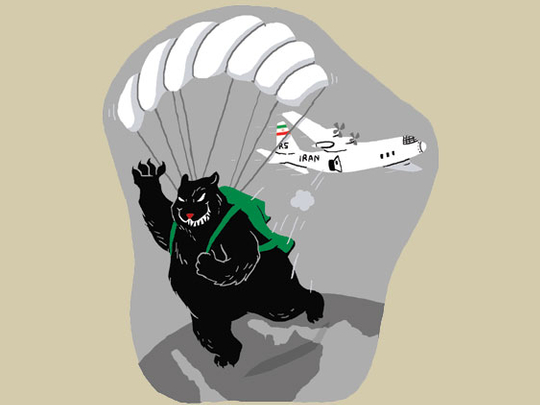
In 1984 a movie named Red Dawn was released. It tells the story of a group of High School kids from Colorado who almost defeat a Russian and Cuban invasion of their hometown. The over-blown view of the threat of the Russian military then is similar to views of the threat of the Iranians and their military today.
Like all bogeymen, the fear of them does not match their reality. Iran’s military has been degraded from decades of sanctions and has seen its ability to project force crippled. The main elements of traditional symmetrical military operations are the Air Force, Navy and Army. The Iranian Air Force’s capabilities have been severely hampered through the lack of spare parts due to international embargoes. Its best fighter jets are the basic Soviet export version of the old MiG-29, and F-14s that have been in service from before the Iranian revolution. Its navy has a hodgepodge of ancient surface vessels, mediocre submarines, and modern small (but very vulnerable) fast-attack boats. While the Iranians have large ground forces, it is hampered by a lack of amphibious or airborne lift capability in order to project/transport their forces across the Gulf; notwithstanding the presence of the US Fifth Fleet. Iran therefore cannot use its ground forces to achieve strategic objectives.
The Iranian military is hampered by a system of embargoes that doesn’t allow it to purchase modern equipment from outside sources. Its military industry has made some strides in military production but many of its “indigenous designs” are simply copies or modifications of obsolete 1970s equipment. Its economic situation means that it cannot invest in the production of conventional equipment in large number to impact the regional balance of power.
Consequently, Iran has concentrated its resources in asymmetrical warfare. It has a long coastline on the Arabian Gulf, many strategic islands in the Gulf itself, and a vast mountainous interior. These geographical features allow it to engage in asymmetrical warfare involving the use of a combination of anti-ship missiles (ASM), mines, ballistic missiles, cruise missiles, and light aircraft. Iranian ASMs are an important part of its asymmetrical warfare doctrine. Iran has large quantities stockpiled in the Iranian-occupied islands in the Arabian Gulf and along its coastline. In July 2006, a Chinese-manufactured C-802 ASM fired by Hezbollah from the Lebanese coast was responsible for severely damaging the Israeli ship INS Hanit. It was given to Hezbollah, and is suspected to have been operated by, the Iranian Revolutionary Guard Corps (IRGC). But the problem with such systems is that Iran can only sustainably deploy them from ground-based launchers. This significantly narrows down the areas where these launchers can be used, offering opposing forces a better chance of finding and neutralising them. Additionally, the Hezbollah missile was successful in part due the fact that it was completely unexpected, something that will not happen in the Gulf.
Iran’s ballistic missile capabilities, while impressive, do not allow it to compensate for its inability to field an effective airforce. While targeting civilian sites is a possibility for the Iranian ballistic and cruise missile force, the targeting of military installations and units effectively will prove to be difficult. There are a number of reasons for this: Ground and naval forces do not necessarily require the use of installations for very long periods of time, Airforce assets do require such support but the widespread use of Hardened Aircraft Bunkers (HABs) and improvised landing strips (like the modification of highways as landing strips as in Taiwan and Sweden for example) means that dependence on such infrastructure can be significantly reduced. Combined with the introduction of medium to long-range missile defence systems in the GCC, the striking power of a ballistic missile force is greatly reduced.
Another important point is that Iran’s stockpiles of ballistic missiles may be too few in number to have a major impact due to the sheer amount of targets it would have to engage. Ports, bridges, airbases, airports, and other installations would run into the tens of thousands. Iran probably has around 1,000 ballistic missiles (ranging from the older Scud-B variants up to its newer Shahab-3 missile, a modified version of the Korean no-dong missile). It is therefore logical to assume that while concentrated use of ballistic and cruise missile assets could damage some regional civilian and military infrastructure there is nothing to say that it could cripple everyday civilian life and military operations. The Iranian ability to deliver its cruise and ballistic missile systems accurately has not been proven under operational combat conditions. Iran claims that the accuracy of its Shahab-3s falls to around 200m CEP (cruise missiles, highly accurate usually have a CEP of under 100m). But this accuracy is under test conditions, hardly similar to warfighting conditions. The rapid development of Satellite and Unmanned Aerial Vehicle (UAV) technology will enhance the acquisition and targeting of ballistic missiles, both fixed and mobile, and degrade the Iranian ability to hit their targets. The Iranian missile forces may end up devoting a significant amount of their time to trying to survive a response from firing such missiles.
Iranian naval mining of the Arabian Gulf, and most specifically the strait of Hormuz is perhaps the most difficult to counter. Naval mines can be deployed through specialised vessels, civilian vessels, and aircraft. In 1988, the US frigate Samuel B. Roberts struck an Iranian naval mine and was almost lost. Naval mine deployment on a large scale would greatly restrict and hamper oil shipments and maritime trade in the Arabian Gulf, and would prove difficult, but not impossible to counter. But the mining of the Gulf would affect Iranian oil revenues as much of it not more than its enemies. GCC countries are seeking ways to avoid the Strait of Hormuz with the UAE building facilities on the Gulf of Oman.
While Iran sustained an eight-year conflict with Iraq, it quickly found itself out of options when it started to confront the US fleet in the tanker wars of 1988. Iran’s strategy then and now is not game-changing in nature nor sustainable. Targeting cities and states that have not directly threatened Iran with ballistic and cruise missiles will make it an international pariah, ala Iraq of 1990. Mining the Gulf and deploying ASMs would lock down trade not only for the Arabian Gulf states but for Iran itself. Once they have deployed their asymmetric card, the Iranian armed forces will quickly find themselves without air cover and subject to repeated air strikes. As in Libya, they will have to watch as their air force and navy are annihilated. Subsequently, their opponents will have a free hand to wear down their asymmetrical warfare capabilities through raids and air strikes. The Iranian military industries would probably share a similar fate. Iran would eventually realise that with its forces deteriorating and its asymmetrical warfare only expanding the scope and breadth of challenges it faces, it would be time to throw in the towel.
The availability of asymmetric warfare assets will therefore most probably turn into a strategic weakness if used. Because they are the only offensive military assets that Iran commands, they will be used as a last resort and will most probably be significantly degraded.
One of the reasons the Soviet Union broke up was that it saw that it could not hope to achieve its political goals through its military capabilities. Hopefully, like the USSR before them, the Iranians will realise they don’t have the military abilities to achieve their goals. And unlike the USSR, a bloody war will not be needed to show them up. Brinksmanship and the escalation of regional tensions will most probably be unsuccessful in the long-term, and the sooner Iran realises this, the faster it can rejoin the international community. Here’s hoping for an Iranian bear devoid of the need to parachute from planes.
Ahmed Al Attar is a defence affairs commentator. You can follow him at www.twitter.com/ahmedwalattar









